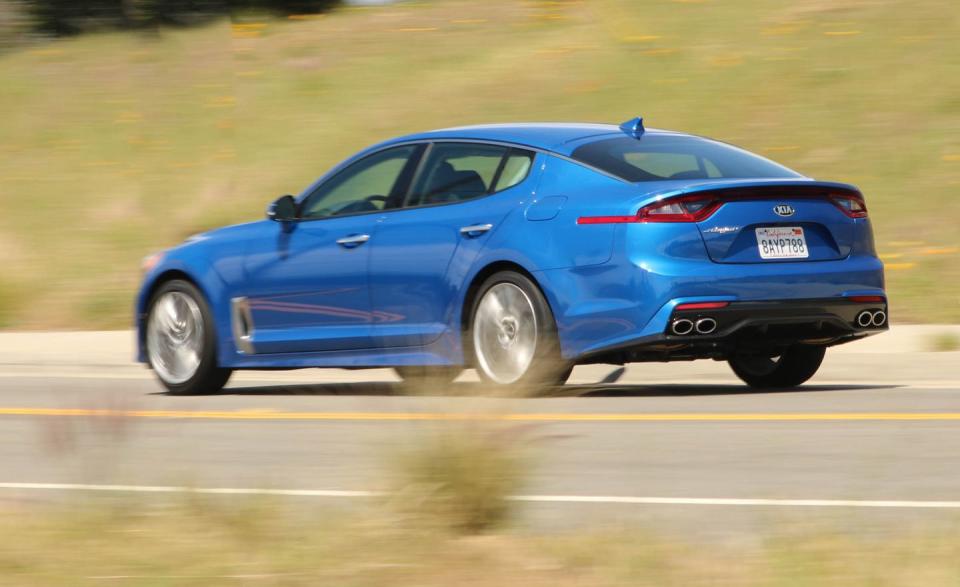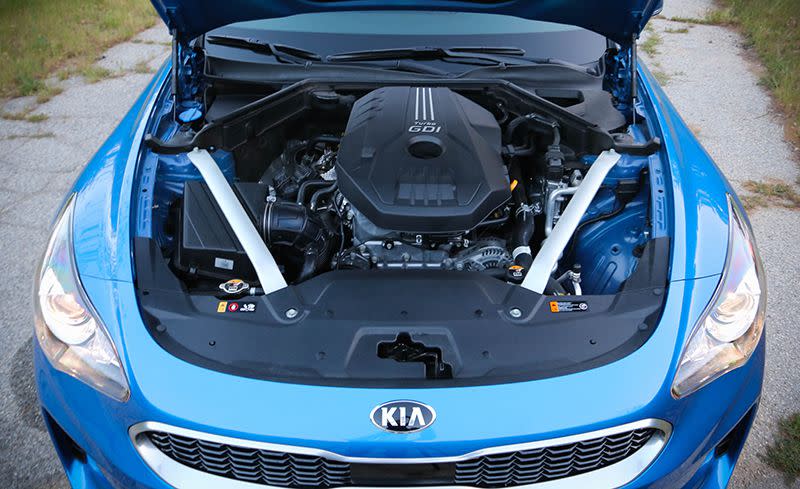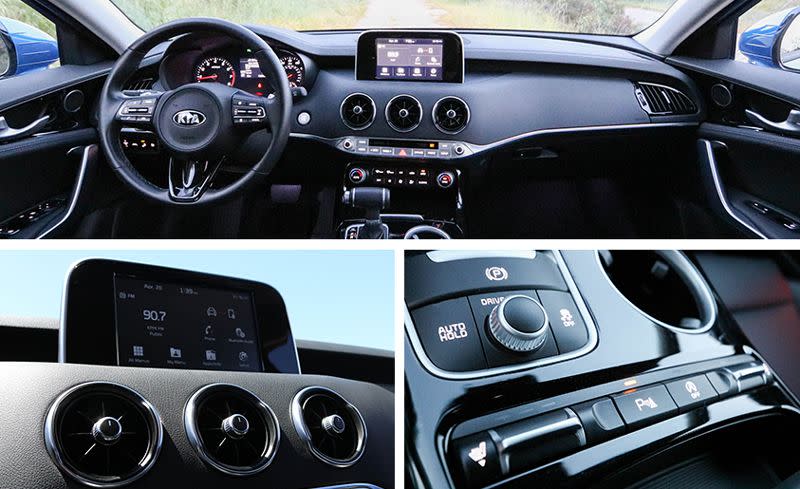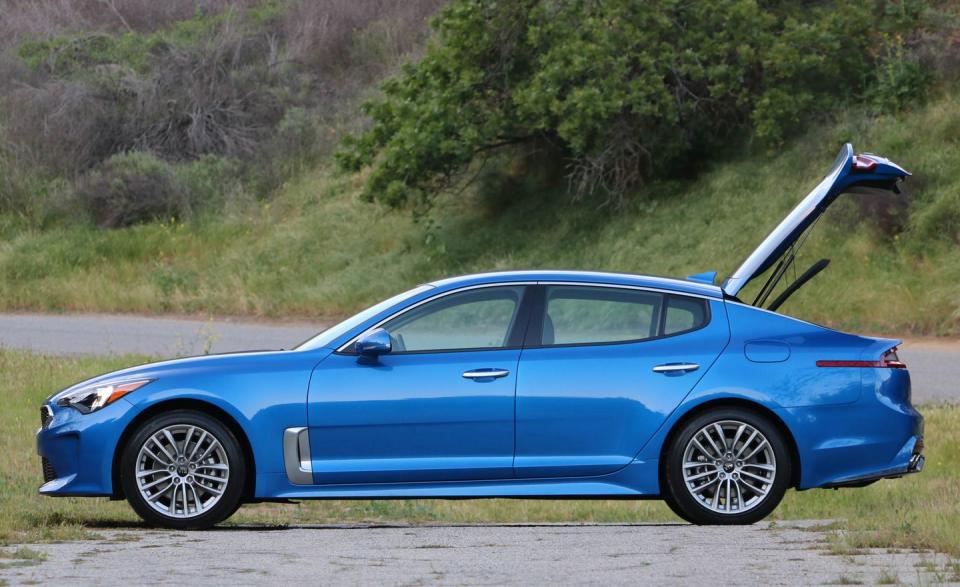2018 Kia Stinger 2.0T RWD

At this point, it’s easier to count the automakers that haven’t fielded a so-called “3-series fighter” than those that have. And while the BMW in its current form may not be the benchmark it once was, the sports-sedan segment in which it competes is more contentious than ever, with the field crowded not only with fellow Germans such as Audi and Mercedes-Benz but also by entrants from the likes of Jaguar, Infiniti, Cadillac-and yes, Kia. Its new Stinger, which we quite like, is clearly aiming to muscle into this growing establishment, even if it’s shaped a bit more like these sedans’ hatchback offshoots such as the Audi A5 Sportback and the BMW 4-series Gran Coupe.
But now that we’ve sampled the base-engine, rear-wheel-drive Stinger 2.0T you see here, we’re starting to think that this version might fit into a wildly different realm. Rather than a true 3-series competitor, could this car instead be Kia’s answer to the Ford Mustang and the Chevrolet Camaro?
For even deeper coverage of the Stinger, view our Buyer’s Guide in-depth review.
Before you call us crazy, hear us out. Despite having four doors to those pony cars’ two, the base Stinger has a fair amount in common with those all-American icons. There are powertrain similarities in that all feature rear-wheel drive combined with a standard turbocharged four-cylinder engine. The cars are close in length, the Stinger coming in at 190.2 inches, while the Camaro is 188.3 and the Mustang 188.5 inches. And the Kia has a sporty, low-slung roofline not entirely unlike the Mustang’s. The array of vents, scoops, and trim pieces that pepper the Stinger’s smooth body lines also seem closer to the pony-car aesthetic than to the classy restraint of most European sports sedans.
The Kia costs a similar amount as the pony cars, too. Although its base price of $32,800 is several thousand dollars more than the opening prices of the four-cylinder Mustang and Camaro, equipping the Ford and the Chevy to the base Stinger’s generous level of standard equipment-including heated front seats, dual-zone automatic climate control, and a 7.0-inch touchscreen with Apple CarPlay and Android Auto-requires an outlay similar to our test Stinger’s $34,800 bottom line, a figure that included a $2000 package of driver-assist and active-safety features.
The base Stinger’s cabin is noticeably less rich than those of the pricier Stingers we’ve driven, making do with a smaller touchscreen, a more basic info display in the gauge cluster, and generally lower-grade plastics. It’s a fairly dour atmosphere, at least with the black upholstery in our test example. Assembly quality is good, though, and while it might not stack up appearance-wise to, say, a Mercedes C-class or an Audi A4, it’s perfectly competitive with the more humble cabins of the Camaro and Mustang.
Lacking Muscle
With a turbocharged inline-four placed longitudinally under its long hood, the Stinger appears to match up nicely with the Mustang and Camaro’s base engines. But Kia’s 2.0-liter turbo four with 255 horsepower and 260 lb-ft of torque is well off the pace of the Chevy, which gets 275 horses and 295 lb-ft out of the same displacement, and the Ford, which wrings 310 ponies and 350 lb-ft from its larger 2.3-liter four.
Predictably, the Stinger’s 6.0-second run from zero to 60 mph (0.1 second quicker than its heavier AWD counterpart) was more than half a second behind the quickest times we’ve run in four-cylinder Mustang EcoBoosts and Camaro 2.0Ts. The four-door Kia also carries more weight than the pony-car coupes: 3688 pounds, to the Mustang’s 3556 and the Camaro’s 3410. Neither are the powertrains exactly an apples-to-apples comparison, as those cars had six-speed manual transmissions-an option that unfortunately isn’t offered on any Stinger. Luckily, the Kia’s eight-speed automatic is a mostly willing partner, with smooth shifts and gearing that makes the most of the 2.0T’s torque curve.
The Stinger’s engine, although not nearly as eager to rev as the exceptional 2.0-liter turbo fours offered by BMW and Audi, is refined and smooth enough throughout the rev range. And the car feels peppier than its middling numbers might suggest, notably its slow 7.2-second 5-to-60-mph rolling-start acceleration, which forgoes the automatic transmission’s launch-control mode. It also exerted a clear advantage over the Mustang in our 75-mph highway fuel-economy test, hitting 34 mpg to the Mustang EcoBoost’s disappointing 24 mpg.
Playful and Poised
Carrying 157 fewer pounds than its AWD counterpart and 316 less than the V-6–powered Stinger GT, this Stinger proved to be light on its feet and arguably the most playful version we’ve sampled so far. There’s a cohesiveness here that’s missing from the more nose-heavy six-cylinder car, as the front and rear suspensions seem to work better in tandem to deliver balanced, confident handling, even as the limit is approached. The damping is satisfyingly tight, the steering is just about perfectly weighted in the standard Comfort mode (it’s a bit too heavy in Sport mode), the brake pedal is firm, and the car’s weight transfers predictably. The Stinger 2.0T is a real driver’s car with lithe responses; the primary improvement we’d request would be an extra measure of feel and feedback through the steering wheel.
The rear-drive Stinger wasn’t quite as strong as its AWD sibling at the test track, falling 0.03 g short of its skidpad result and taking three feet longer to stop from 70 mph, despite wearing identical 18-inch wheels and Bridgestone Potenza RE97AS-02 all-season tires. We can’t help but wonder what the four-cylinder Stinger could do if it were fitted with more aggressive summer rubber like the 19-inch Michelin Pilot Sport 4 tires offered on the GT.
It’s All in the Hatch
Clearly, the biggest differences between the Stinger and the Mustang and Camaro are in the cars’ packaging. Despite its sleek and attractive silhouette, the Kia is an eminently practical machine with a spacious rear seat and a capacious cargo area under its wide-opening hatch. Thanks to its extra doors and its flat-folding rear seats, it will much more easily accommodate families and/or cargo than the Mustang and Camaro with their cramped rear seats and small trunks with restrictive openings.
Of course, the other stark difference is that the Mustang and Camaro are steeped in heritage, whereas the Stinger has none. And while we admit that the Stinger is unlikely to be cross-shopped by the often die-hard buyers of these pony cars, the similarities nevertheless play up the Kia’s unique position in the marketplace. Particularly in four-cylinder, rear-wheel-drive form, the Stinger is a playful, affordable, and practical take on the sports sedan-not just another BMW 3-series clone.
('You Might Also Like',)

 Yahoo Autos
Yahoo Autos 



